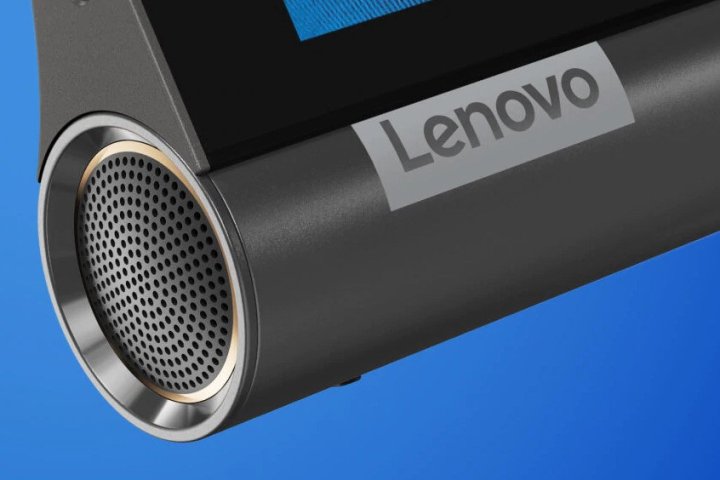“As its name implies, this Android tablet proves to be smart and flexible, with plenty of useful features.”
- Built-in kickstand
- You can hang it
- Works as smart home hub
- Google Assistant built in
- YouTube dashboard is glitchy
- Unbalanced weight
The Lenovo Yoga Smart Tab is an Android tablet that really stands out from its competitors. It packs an assortment of useful features into a 10.1-inch device, including a versatile kickstand, Google Assistant, smart hub capabilities, and much more. Here’s a look at just how smart the Yoga Smart Tab really is.
If you’re on the lookout for affordable tablet options, check out the Black Friday tablet deals list for more.
Design

Where most tablets need outside help in the form of covers or stands, the Yoga Smart Tab is built to do whatever you need it to do. It has a built-in stand that pops out with the press of a button for movie watching and can be adjusted to the angle you need. It also has a prop to make typing easier when it is laying on a flat surface. You can even hang it on a wall, if the need ever arises, using the kickstand.
Since there are speakers on one side of the tablet, it’s a little awkward to hold, especially in portrait mode, since it’s heavier on one side than the other. It’s also a little bit chunky, which made my arm tired. It weighs 1.28 pounds (581 grams). Meanwhile, the Galaxy Tab S6 weighs 0.92 pounds (420g), and the Amazon Fire HD 10 weighs 1.11 pounds (504 g). That may not seem like a big difference, but when you’re holding a tablet for an hour or two, every little bit counts.
The 10.1-inch FHD IPS (1920 x 1200) screen is very clear and didn’t have much distortion when viewing it from different angles. The colors are vibrant and, when looking at photos, it almost seemed like I was looking at a high-quality print.
Software
The Yoga Smart Tab is smarter than a normal tablet because it has a dedicated Google Assistant mode, and a bevy of skills along with it. Opening the tablet stand automatically turns on Google Assistant’s Ambient Mode. The tablet turns the always-on display into a smart screen that displays the weather, your agenda, entertainment you may like, reminders, and more. Most tablets don’t have access to Ambient Mode, so this is a great extra feature.
I really like the Ambient option because it makes it even more useful than your average Android tablet.
If you don’t want all of that jazz on your screen, you can also use the feature to make your tablet a photo frame, or a remote control for your Google Assistant compatible smart home devices. I really like the Ambient option, because it makes it even more useful than your average Android tablet. Plus, it has 360-degree far-field voice recognition, which means Google Assistant will hear you no matter where you are in the room.
Audio Quality

Another feature that sets the Yoga Smart Tab apart from other tablets, like the Samsung Galaxy Tab S6, is that it has speakers on both sides of the screen. The dual JBL hi-fi speakers and Dolby Atmos support do a pretty good job.
If you turn the volume up all the way it loses its quality.
The bass is nice as long as you don’t want it to bump too much, or listen at full volume. If you turn the volume up all the way it loses its quality, which can be a bummer if you like listening to YouTube videos on your tablet, though most tablets have this problem.
Performance

The Yoga Smart Tab also has a literal smart tab. You drag the tab to the right, and it opens a YouTube dashboard. Though this is convenient, it’s also glitchy. Sometimes I couldn’t get videos to play through the dashboard (I just saw the buffering circle of doom). However, if I opened the actual YouTube app, videos played perfectly.
The screen’s performance was excellent good. Scrolling, navigating, and opening up apps were smooth, without any of the lag that you find with some tablets. With a Qualcomm Snapdragon 439 processor and 4GB of RAM, however, it’s not a great choice for graphics-intensive games. Many 3D titles will stutter and hesitate.
The battery life on the Tab is decent. It can last for up to 11 hours if you’re just browsing the internet and offers up to 10 hours of video playback. This is comparable with the battery life we experienced with the Galaxy Tab S6.
Our take
While it’s not perfect, the Yoga Smart Tab by Lenovo is a dependable, dual-purpose device that combines the smart display with a tablet. Its versatile stand and smart home hub features make it more useful that many tablets on the market. Otherwise, the screen and sound are on par with its competitors. The only real drawback is the unbalanced feel and the added weight when you’re holding the Smart Tab.
Are there better options out there?
Maybe. It just depends on your needs. If you’re looking for an outstanding Android tablet, the Galaxy Tab S6 is tough to beat. One thing that the S6 doesn’t have, though, is Google Assistant’s Ambient Mode feature, which means it can’t be used as a hub for your smart devices like with the Yoga Smart Tab. If the hub wasn’t all that interesting to you, you may want to go with the S6. If price is a factor, the Yoga Smart Tab, at around $300, is also half the price of the S6.
How long will it last?
The Smart Tab is very well made, and I think it will go the distance since it is constructed with aluminum instead of just plastic. It also comes with a one-year warranty.
Should you buy it?
Yes, if you have a lot of smart home products that are compatible with Google Assistant, this tablet is a great choice.





